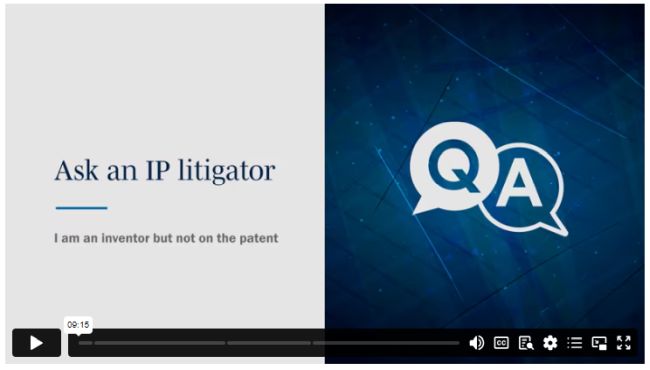Video transcript
Teresa Reguly (00:05): What happens if you've invented a product but your name isn't listed on the patent that covers it? Will this cause issues for the patent? And can this be rectified? I'm Teresa Reguly and I'm here with my colleague, Yael Bienenstock, to discuss what it means to be an inventor for patenting purposes.
Teresa Reguly (00:23): Yael, first off. What is an inventor?
Yael Bienenstock (00:26): Well, the term "inventor" is actually not expressly defined in the Patent Act, but usually what courts look for in deciding who's an inventor is who's responsible for the so called "inventive concept" of the patent. Now, that's a pretty nebulous term, but what courts usually think about is who had the "spark" or the idea. Patents are all about ideas.
So who had the idea that led to the definite and practical outcome that form the basis for the patent? So being an inventor is more than just thinking about a problem, it's about the conception of a solution to a problem or the inventive concept. It doesn't matter how much you contribute, even a small contribution is enough to be inventors. I know we all see patents, sometimes there's like six or ten inventors, and usually it means that different inventors thought of different things that came together to put together the idea that formed the basis for the patent. But you have to do simply more than verifying steps or mechanical testing. It can't just be like, I have an idea, someone else had an idea and now I'm just going to make sure it works. You actually have to have an idea to have an invention. So, Teresa, let me put this to you. What's the difference between inventorship and ownership of a patent?
It's a good distinction, Yael. So you can't have an arrangement or an agreement between parties to determine inventorship. You know, as Yael just walked us through, inventorship is an assessment of the persons who actually contributed to that inventive idea. I also want to note that inventorship is different than authorship on scientific publications. So it very well may be that there are publications out there with a list of persons as authors, you know, due to the rules of the particular journal or other contributions that were given.
That doesn't mean that they're actually an inventor for patent purposes. The inventor, as Yael said, is who contributed to that idea that forms the concept that we're trying to capture within that application. When you file the patent application, you do have to list out all the inventors. The right to file the application and the rights to the patent that ultimately issue from that application don't necessarily stay with the inventor. Those rights can and typically are transferred to another entity. So the applicant that's listed on the application is the person that has the right to file that application. The default may be the inventors. But typically, patent applications are filed in the name of another entity. So, for example, when inventions are made in the course of an employment arrangement by employees, typically the terms of the employees' contract or common law principles will transfer rights in the patent application to the employer.
And as patent agents, we are typically filing confirmatory assignments with the Patent Office as evidence of this assignment of rights from inventors to the actual applicant. It's important to keep in mind that while the holder of the entitlement to the rights can change over time, inventorship doesn't change over time. So that's determined at the time of filing the application.
Teresa Reguly (03:35): So back to you, Yael. Let's say that the inventors are not properly listed on the patent. Is that a problem?
Yael Bienenstock (03:41): The short answer to that question is: not really. It's definitely something you have to deal with, and we're going to talk about how, and it should be corrected, but it's unlikely to be kind of a "make it or break it" problem. And the reason for that is that there's no heading of invalidity in the Patent Act under the heading "wrong inventor".
And so the way this is usually dealt with is under section 53 of the Patent Act, which is the kind of "fraud provision" in Canada, and it has a pretty high bar. So section 53 provides that a patent is void if any material allegation in the petition of the applicant in respect of the patent is untrue. And so then the question becomes, is omitting an inventor or putting in the wrong inventor, is that a material allegation?
And generally, courts have said the answer to that is: no. They say it's immaterial because it doesn't impact the term of the patent, the substance of the invention or the entitlement to the rights established by the patent. And so in most cases, courts find that there was no actual material misstatement based on inventorship, or there wasn't any misstatement at all.
And if there wasn't a misstatement, it wasn't material, or that there was no willful intent to mislead by not listing the inventors correctly, which is also an aspect of section 53. Now, whether that intention to mislead applies to wrong inventors or not, there is some controversy about that. But there is some suggestion in the case law that to invalidate a patent based on wrongly-named inventors, there has to be some evidence of an intention to mislead.
And so that is a pretty high bar. At a minimum, it presents another hurdle for a party that's hoping to invalidate a patent on that basis. So it's pretty hard to succeed on this allegation, not that it isn't made, but in most cases, if not all cases, it is usually unsuccessful. But getting back to my first point, it's something you have to fix.
Yael Bienenstock (05:41): How do you fix it?
Teresa Reguly (05:42): Right. So it is pretty common to have incorrectly-named inventors on a patent application. At the application stage, so before the final fee is paid and the patent's about to issue, assuming everyone's in agreement, there's no argument about who the inventors should be. It's very easy to correct the inventors. You would just submit a request to the Patent Office. Patent Office will review your request and update the records. And when the patent issues, all of the right persons will be named.
If the situation is more complex than there are provisions under the Patent Act that can be useful. So, for example, there's a section of the Patent Act that says: if one of the inventors doesn't wish to assist with the patent application, the other inventors can proceed on their own if they provide evidence of that inventor has refused to cooperate or that an inventor can't be located.
And normally this is done through sworn affidavits of the facts. Those are submitted to the Patent Office. Patent Office reviews, and typically this will be corrected. Patent Act also allows for addition of a joint applicant, where the applicant was inadvertently or mistakenly omitted, or to remove an applicant who had no role in the invention. So there's various procedural ways before the Patent Office that you can correct these inventorship and chain of title issues.
Now, if things are contested, then we will go back to Yael to take us through what happens if we do have to go and deal with this in the court.
So typically the cases that the courts have dealt with or after the patent has issued so you're not talking about a patent application, you're dealing with an issued patent. And under section 52 of the Patent Act, the Federal Court "...has jurisdiction on the application of the Commissioner, or any interested person to order that any entry in the records of the Patent Office relating to the title to a patent be varied or expunged."
And the Federal Court's jurisdiction courts have held, under section 52 covers matters relating to the root of title, and it includes the authority to order both inventors and owners to be added or removed from a patent. Now, it's not clear whether that extends to patent applications. And so typically issues of inventorship and the applicant are resolved through CIPO, as Teresa you explained.
The other point that's kind of interesting about section 52 is that we talk about inventorship and ownership, and inventorship is really all about the invention and who thought of it, and things that very clearly fall within the patent power under the Constitution Act, 1867 and division of powers. When we're talking about ownership, we're talking about chain of title, contracts, things that are usually under provincial jurisdiction.
And so there was sort of some dispute about the extent to which a federal court under section 52 could address ownership issues. And let's say you're if you're talking about inventorship and ownership issues, do you have to go to Ontario court for your contract disputes? And then, to the extent they're related to the federal court, go back to the federal court for the inventorship disputes. But there is a recent case from—well, not so recent actually anymore—2020, I believe, the Salt and Baker case from the Federal Court of Appeal that held that section 52 includes federal jurisdiction over patents, and that includes the ability to determine ownership issues where they arise in the context of title to a patent. So I think that that issue has now been nailed down.
In the world of innovation, owning the intellectual property rights to a product is a crucial step, but who gets to own those rights isn't always clear.
In this video, Teresa Reguly and Yael Bienenstock discuss what it means to be an inventor, how the patent application works, and strategies for fixing patent application mistakes.
Topics include:
- how inventorship is assessed
- the difference between inventorship and ownership
- steps to take if an inventor is not listed on a patent
The content of this article is intended to provide a general guide to the subject matter. Specialist advice should be sought about your specific circumstances.


